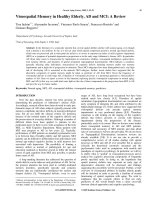Tài liệu Statistical Issues In Interactive Web-based Public Health Data Dissemination Systems doc
Bạn đang xem bản rút gọn của tài liệu. Xem và tải ngay bản đầy đủ của tài liệu tại đây (221.42 KB, 55 trang )
Statistical Issues in
Interactive Web-based
Public Health Data
Dissemination Systems
MICHAEL A. STOTO
WR-106
October 2003
Prepared for the National Association of Public Health Statistics and
Information Systems
Statistical Issues in Interactive Web-based
Public Health Data Dissemination Systems
EXECUTIVE SUMMARY
State- and community-level public health data are increasingly being
made available on the World Wide Web for the use of professionals and the
public. The goal of this paper is to identify and address the statistical issues
associated with these interactive data dissemination systems. The analysis is
based on telephone interviews with 14 individuals in five states involved with the
development and use of seven distinct interactive web-based public health data
dissemination systems, as well as experimentation with the systems themselves.
Interactive web-based systems offer state health data centers an
important opportunity to disseminate data to public health professionals, local
government officials, and community leaders, and in the process raise the profile
of health issues and involve more people in community-level decision making.
The primary statistical concerns with web-based dissemination systems relate to
the small number of individuals in the cells of tables when the analysis is focused
on small geographic areas or in other ways. In particular, data for small
population groups can be lacking in statistical reliability, and also can have the
potential for releasing confidential information about individuals. These concerns
are present in all statistical publications, but are more acute in web-based
systems because of their focus on presenting data for small geographical areas.
Statistical Issues in Web-Based Public Health Data Systems 2
Small numbers contributing to a lack of statistical reliability
One statistical concern with web-based dissemination systems is the
potential loss of statistical reliability due to small numbers. This is a concern in
all statistical publications, but it is more acute in web-based systems because of
their focus on presenting data for small geographical areas and other small
groups of individuals.
There are a number of statistical techniques that interactive data
dissemination systems can use to deal with the lack of reliability resulting from
small cell sizes. Aggregation approaches can help, but information is lost. Small
cells can be suppressed, but even more information is lost. (The best rationale
for numerator-based data suppression is confidentiality protection, not statistical
reliability.) In general, approaches that use statistical approaches to quantify the
uncertainty (such as confidence intervals and the use of c
2
tests), or to
smoothing, or small area model-based estimation, should be preferred to options
that suppress data or give counts but not rates.
Small numbers and confidentiality concerns
The primary means for protecting confidentiality in web-based data
dissemination systems, as in more traditional dissemination systems, is the
suppression of “small” cells, plus complementary cells, in tables. The definition
of “small” varies by state, and often by dataset. This approach often results in a
substantial loss of information and utility.
Statisticians in a number of state health data centers have recently
reconsidered data suppression guidelines currently in use and have developed
Statistical Issues in Web-Based Public Health Data Systems 3
creative and thoughtful new approaches, as indicated above. Their analyses,
however, have not been guided by theory or statistical and ethical principles, and
have not taken account of extensive research on these issues and development
of new methods that has taken place in the last two decades. Government and
academic statisticians, largely outside of public health, have developed a variety
of “perturbation” methods such as “data swapping” and “controlled rounding” that
can limit disclosure risk while maximizing information available to the user. The
Census Bureau has developed a “confidentiality edit” to prevent the disclosure of
personal data in tabular presentations. The disclosure problem can be
formulated as a statistical decision problem that explicitly balances the loss that
is associated with the possibility of disclosure and the loss associated with non-
publication of data. Such theory-based and principled approaches should be
encouraged.
Concept validity and data standards
Statisticians have been concerned ever since computers were introduced
that the availability of data and statistical software would lead untrained users to
make mistakes. While this is probably true to some extent, restricting access to
data and software is not likely to succeed in public health. The introduction of
interactive web-based dissemination systems, on the other hand, should be seen
as an important opportunity to develop and extend data standards in public
health data systems.
Web-based dissemination systems, because they require that multiple
data systems be put into a common format, present opportunities to disseminate
Statistical Issues in Web-Based Public Health Data Systems 4
appropriate data standards and to unify state data systems. Educational efforts
building on the dissemination software itself, as well as in more traditional
settings, are likely to be more effective in reducing improper use of data than
restricting access. For many users, such training will need to include content on
using public health data, not just on using web-based systems. The
development of standard reports for web-based systems can be an effective
means for disseminating data standards.
Data validation
No statistical techniques can guarantee that there will be no errors in web-
based data systems. Careful and constant checking of both the data and the
dissemination system, as well as a policy of releasing the same data files to all
users, however, can substantially reduce the likelihood of errors. Methods for
validation should be documented and shared among states.
The development of web-based dissemination systems is an opportunity
to implement data standards rather than a problem to be solved. Efforts to check
the validity of the data for web dissemination purposes may actually improve
overall data quality in state public health data systems.
General comments
The further development and use of web-based data dissemination
systems will depend on a good understanding of the systems’ users and their
needs. System designers will have to balance between enabling users and
protecting users from themselves. Systems will also have to develop ways to
Statistical Issues in Web-Based Public Health Data Systems 5
train users not only in how to use the systems themselves, but also on statistical
issues in general and the use of public health data.
Research to develop and implement new statistical methods, and to better
understand and address users’ needs, is a major investment. Most states do not
have the resources to do this on their own. Federal agencies, in particular
through CDC’s Assessment Initiative, could help by enabling states to share
information with one another, and by supporting research on the use of new
statistical methods and on data system users.
Statistical Issues in Web-Based Public Health Data Systems 6
INTRODUCTION
State- and community-level public health data are increasingly being
made available on the World Wide Web for the use of professionals and the
public. Although most data of this sort currently available are simply static
presentations of reports that have previously been available in printed form,
interactive web-based systems are increasingly common (Friedman et al, 2001).
The goal of this paper is to identify and address the statistical issues
associated with interactive web-based state health data dissemination systems.
This will include assessing the current data standards, guidelines, and/or best
practices used by states in their dissemination of data via the Web for both static
presentation of data and interactive querying of data sets and analyzing the
statistical standards and data dissemination policies, including practices to
ensure compliance with privacy and confidentiality laws. Many of the same
statistical issues apply to public health data however published, but interactive
web-based systems make certain issues more acute. In addition, identifying and
addressing these issues for interactive systems may also lead to overall state
health data system improvement.
This analysis is based on telephone interviews with 14 individuals in five
states involved with the development and use of seven distinct interactive web-
based public health data dissemination systems, as well as experimentation with
the systems themselves. All but one of the systems are currently in operation,
but most are constantly being updated. The interviewees and information on the
sites appears in Appendix A. The choice of these individuals and states was not
intended to be exhaustive or representative, but to bring out as many statistical
Statistical Issues in Web-Based Public Health Data Systems 7
issues as possible. In addition, a preliminary draft of this paper was circulated for
comment and was discussed at a two-day workshop at Harvard School of Public
Health in August, 2002; attendees are listed in Appendix B. The current draft
reflects comments by e-mail and at the workshop, but the analysis and
conclusions are the author’s, as well as any errors that may remain.
This paper begins with a background section that addresses the purposes,
users and benefits of interactive data dissemination systems, systems currently
in place or being developed, and database design as it affects statistical issues.
The body of the paper is organized around four substantive areas: (1) small
numbers contributing to a lack of statistical reliability; (2) small numbers leading
to confidentiality concerns; (3) concept validity and data standards, and (4) data
validation. The paper concludes with a summary and conclusions. A glossary of
key terms appears in Appendix C.
BACKGROUND
Purposes, users, and benefits of interactive data systems
Interactive web-based data dissemination systems in public health have
been developed for a number of public health assessment uses. One common
use is to facilitate the preparation of community-level health profiles. Such
reports are consistent with Healthy People 2010 (DHHS, 2000), and are
increasingly common at the local/county level. In some states, they are required.
This movement reflects the changing mission of public health from direct delivery
of personal health care services to assessment and policy development (IOM,
Statistical Issues in Web-Based Public Health Data Systems 8
1996, 1997). The reports are used for planning and priority setting as well as for
evaluation of community-based initiatives.
Minnesota, for instance, will use its interactive dissemination system to
reshape the way that state and county health departments do basic reports by
facilitating, and hence encouraging, the use of certain types of data. The system
is intended to provide better and more current information to the public than is
available in the current static system, in which data are updated only every two
years.
From another perspective, the purpose of web-based dissemination
systems is to enable local health officials, policy makers, concerned citizens, and
community leaders who are not trained in statistics or epidemiology to participate
in public health decision-making. Because many of these users are not
experienced data users, some systems are designed to help users find
appropriate data. MassCHIP, for instance, was designed with multiple ways into
datasets so users are more likely to “stumble upon” what they need. Users can
search, for instance, using English-language health problems lists and Healthy
People objectives, as well as lists of datasets.
Web-based dissemination systems are also a natural outgrowth of the
activities of state health data centers. The systems allow users to prepare
customized reports (their choice of comparison areas, groups of ICD codes, age
groups, and so on). So in addition to making data available to decision makers
and the public, they also facilitate work already done by state and local public
health officials and analysts. This includes fulfilling data requests to the state
data center as well as supporting statistical analyses done by subject area
Statistical Issues in Web-Based Public Health Data Systems 9
experts. States have seen substantial reduction in the demand on health
statistics staff for data requests. In at least one case, the system itself has
helped to raise the profile of the health department with legislators.
Interactive web data systems are also being used to detect and
investigate disease clusters and outbreaks. This includes cancer, infectious
diseases, and, increasingly, bioterrorism. Interactive web systems are also being
used, on a limited basis, for academic research, or at least for hypothesis
generation. The software that runs some of these systems (as opposed to the
state health data that are made available through it) has also proven useful for
research purposes. Nancy Krieger at the Harvard School of Public Health, for
instance, is using VistaPH to analyze socio-economic status data in
Massachusetts and Rhode Island, and others are using it in Duval County,
Florida and Multnomah County, Oregon.
Some states are also building web-based systems to bring together data
from a number of health and social service programs and make them available to
providers in order to simplify and coordinate care and eligibility determination.
Such systems can provide extremely useful statistical data, and in this sense are
included in this analysis. The use of these systems for managing individual
patients, however, is not within the scope of this paper.
Reflecting the wider range of purposes, the users of web-based data
systems are very diverse. They include local health officials, members of boards
of health, community coalitions, as well as concerned members of the public.
Employees of state health data centers, other health department staff, and
employees of other state agencies; hospital planners and other health service
Statistical Issues in Web-Based Public Health Data Systems 10
administrators, public health researchers and students of public health and other
health fields also use the data systems.
These users range from frequent to occasional. Frequent users can
benefit from training programs and can use more sophisticated special purpose
software. Because most users only use the system occasionally, there is a need
for built-in help functions and the like. Tennessee’s system, for instance, is
colorful and easy to use. Elementary school students up to graduate students in
community health courses have used it for class exercises.
Because of the breadth of uses and users, the development of a web-
based dissemination system can lead to consideration and improvement of data
standards and to more unification across department data systems. This
happens by encouraging different state data systems to use common population
denominators, consistent methods, such as for handling missing data, consistent
data definitions, for example for race/ethnicity and common methods for age
adjustment (to the same standard population) and other methods, such as
confidence intervals.
Current web-based public health data dissemination systems
In support of the wide variety of uses and users identified above, current
public health web-based data dissemination systems include many different
kinds of data. Each of the following kinds of data is included in at least one of the
seven data systems examined for this study. Reflecting the history of state
health data centers, vital statistics are commonly included. Most systems also
include census or other denominator data needed to calculate population-based
Statistical Issues in Web-Based Public Health Data Systems 11
rates. In support of community health assessment initiatives, web-based
dissemination systems also typically include information related to Healthy
People 2010 (DHHS, 2000) measures or their state equivalents, and links to
HRSA’s Community Health Status Indicators (HRSA, undated).
Systems also commonly include data “owned” by components of the
public health agency outside the state data center, and sometimes by other state
agencies. Web-based dissemination systems, for instance, typically include
epidemiologic surveillance data on infectious diseases, including HIV/AIDS, and,
increasingly, bioterrorism. Cancer registry data are included in some systems.
Some systems include health services data based on hospitalization, such as
average length of stay and costs, as well as Medicaid utilization data. One
system includes data from outside the health department on TANF and WIC
services.
Although much of the data covered by web-based dissemination systems
is based on individual records gathered for public health purposes, such as death
certificates and notifiable disease reports, population-based survey data are also
included. Data from a state’s Behavioral Risk Factor Surveillance System
(BRFSS) (CDC, undated), youth behavioral risk factor and tobacco surveys
where available, and others, are commonly included.
Demographic detail in web dissemination systems generally reflects what
is typically available in public health data sets and what is used in tabulated
analyses: age, race, sex, and sometimes indicators of socioeconomic status.
Definitions of these variables and how they are categorized frequently vary
across the data sets available in a single state system.
Statistical Issues in Web-Based Public Health Data Systems 12
The geographic detail in web-based dissemination systems, however, is
substantially greater than is typically available in printed reports. State systems
typically have data available for each county or, in New England states, town.
Some of the state systems also have data available for smaller areas in large
cities. Missouri’s MICA makes some health services data available by Zip code.
Some of the systems allow users to be flexible in terms of disaggregation. The
basic unit in MassCHIP is the city/town, but the system allows users to group
these units into community health areas, HHS service areas, or user-defined
groups. The VistaPHs and EpiQMS systems in Washington allow user-defined
groups based on census block.
This geographical focus, first of all, is designed to make data available at
the level of decision-making, and to facilitate the participation of local policy
makers and others in health policy decisions. This focus also allows public
health officials to develop geographically and culturally targeted interventions. In
Washington, for instance, a recent concern about teen pregnancy led public
health officials to identify the counties, and then the neighborhoods, with the
highest teen fertility rates. This analysis led them to four neighborhoods, two of
which were Asian where teen pregnancy is not considered a problem. They were
then able to focus their efforts in the two remaining neighborhoods. In the future
they anticipate using the system to support other surveillance activities as well as
outbreak investigations.
Although the combination of demographic and geographic variables in
theory allows for a great degree of specificity, in actual practice the combination
Statistical Issues in Web-Based Public Health Data Systems 13
of these variables is limited by database design, statistical reliability, and
confidentiality concerns, as discussed below.
Data availability and state priorities drive what is included in web-based
dissemination systems. According to John Oswald, for instance, Minnesota’s
health department has three priorities – bioterrorism, tobacco, and disparities –
so the system is being set up to focus on these. Data availability is a practical
issue; it includes whether data exist at all, are in a suitable electronic form, come
with arrangements that allow or prohibit dissemination, and whether the data are
owned by the state health data center.
State public health data systems are also an arena in which current
statistical policy issues are played out, and this has implications for database
content and design. Common concerns are the impact of the new Health
Insurance Portability & Accountability Act of 1996 (HIPAA) regulations regarding
the confidentiality of individual health information (Gostin, 2001), the recent
change in federal race/ethnicity definitions, the adoption of the Year 2000
standard population by the National Center for Health Statistics (Anderson and
Rosenberg, 1998), and surveillance for bioterrorism and emerging infectious
diseases.
In the future, web-based dissemination systems will likely be expanded to
include more data sets. Some states are considering using these systems to
make individual-level data available on a restricted basis for research purposes.
States are also considering using these systems to make non-statistical
information (e.g. breast cancer fact sheets, practice guidelines, information on
Statistical Issues in Web-Based Public Health Data Systems 14
local screening centers) available to community members, perhaps linked to data
requests on these subjects.
Database design
Current web-based dissemination systems range from purpose-built
database software to web-based interfaces to standard, high-powered statistical
software such as SAS or GIS systems such as ESRI Map Objects that resides on
state computers. System development has been dependent on the statistical,
information technology, and Internet skills available in (and to) state health data
centers. Missouri and Massachusetts built their own systems. Washington
adopted a system built by a major local health department, Seattle-King County.
Tennessee contracted with a university research group with expertise in survey
research and data management. Not surprisingly, the systems have evolved
substantially since they were first introduced in 1997 due to changes in
information technology, and Internet technology, and the availability of data in
electronic form.
The designers of web-based dissemination systems in public health face
two key choices in database development. As discussed in detail below, these
choices have statistical implications in terms of validity checking, choice of
denominator, data presentation (e.g. counts vs. rates vs. proportions, etc.), ability
to use sophisticated statistical methods, and user flexibility.
First, systems may be designed to prepare analyses from individual-level
data “on the fly” – as requested – as in MassCHIP, or to work with preaggregated
data (Missouri’s MICA) or pre-calculated analytical results (Washington’s
Statistical Issues in Web-Based Public Health Data Systems 15
EpiQMS). “On the fly” systems obviously have more flexibility, but the time it
takes to do the analyses may discourage users. This time can be reduced by
pre-aggregation. Rather than maintaining a database of individual-level records,
counts of individuals who share all characteristics are kept in the system.
Different degrees of preaggregation are possible. At one extreme, there are
static systems in which all possible tables and analyses are prepared in advance.
At the other, all calculations are done using individual-level data. In between, a
system can maintain a database with counts of individuals who share
characteristics. The more characteristics that are included, the more this
approaches an individual-level system.
At issue here is the degree of user control and interaction. Static systems
can deliver data faster, but are less flexible in what can be requested and may
limit the user in following up leads that appear in preliminary analyses. The
preprocessing step, however, can provide an opportunity for human analysts to
inspect tables and ensure that statistical analyses supporting more complex
analyses are reasonable. EpiQMS, for instance, uses an “accumulated record”
database – all of the calculations have been done in advance – which allows for
greater speed and a user-friendly design. It also allows the system
administrators to look at the data and see if it makes sense, and also to identify
and fix problems based on human intelligence.
The second major design choice is between a server-resident data and
analytic engine vs. a client-server approach. In a server-resident system, the
web serves as an interface that allows users to access data and analytic tools
that reside on a state health data center server. The only software that the user
Statistical Issues in Web-Based Public Health Data Systems 16
needs is a web browser. In a client-server approach, special purpose software
on the user’s computer accesses data on the state’s computer to perform
analyses. Client-server software allows for greater flexibility (for example, users
can define and save their own definitions of geographical areas), but the
necessity of obtaining the client software in advance can dissuade infrequent
users.
Systems can, and do, combine these approaches. MassCHIP, for
instance, uses client-server software to do analyses on the fly, but makes a
series of predefined “Instant Topics” reports available through the web.
Tennessee’s HIT system uses a combination of case-level and prepared
analyses. Its developers would like more case-level data because it is more
flexible, but these analyses are hard to program, and resources are limited. In
the end, users care more about data than datasets, so an integrated front end
that helps people find what they need is important.
Although all of the systems include some degree of geographical data,
they vary in the way that these data are presented. Washington’s EpiQMS and
Tennessee’s HIT systems feature the use of data maps, which are produced by
commercial GIS software. According to Richard Hoskins, spatial statistics
technology has finally arrived, and the EpiQMS system makes full use of it. The
systems also differ in the availability of graphical modes of presentation such as
bar and pie charts.
The design of web-based dissemination systems should, and does,
represent the diversity of the users as discussed above. A number of systems,
for instance, have different levels for types of users. Users differ with respect to
Statistical Issues in Web-Based Public Health Data Systems 17
their statistical skills, their familiarity with computer technology, and their
substantive expertise, and there is a clear need (as discussed in more detail
below) for education, training, and on-line help screens that reflect the different
skills and expertise that the users bring to the systems.
ANALYSIS AND RECOMMENDATIONS
Small numbers contributing to a lack of statistical reliability
Because of their focus on community-level data, web dissemination
systems for public health data eventually, and often quickly, get to the point
where the numbers of cases available for analysis become too small for
meaningful statistical analysis or presentation. It is important to distinguish two
ways in which this can happen.
First, in statistical summaries of data based on case reports oftentimes the
expected number of cases is small, meaning the variability is relatively high. In
statistical summaries the number of reported cases (x) typically forms the
numerator of a rate (p), which could be the prevalence of condition A per 1,000
or 100,000 population, the incidence of condition B per 100,000 residents per
year, or other similar results. Let the base population for such calculations be n.
There is variability in such rates from year to year and place to place because of
the stochastic variability of the disease process itself. That is, even though two
communities may have the same, unchanging conditions that affect mortality,
and 5 cases would be expected in each community every year, the actual
number in any given year could be 3 and 8, 6 and 7, and so on, simply due to
chance.
Statistical Issues in Web-Based Public Health Data Systems 18
The proper formula for the variance of such rates depends on the
statistical assumptions that are appropriate, typically binomial or Poisson. When
p is small, however, the following formulas hold approximately:
(1) Var (x) = np
(2) Var (p) = Var (x/n) = p/n
Analogous formulae are available for more complex analyses, such as
standardized rates, but the fundamental relationship to p and n is similar.
Since the expected value of the number of cases, x, is also equal to np,
the first formula implies that the standard deviation of x equals the square root of
its expected value. If the expected number of cases is, say, 4, the standard
deviation is ÷4 or 2. If the rate were to go up by 50% so that the expected
number of cases became 6, that would be only about 1 standard deviation above
the previous mean, and such a change would be difficult to detect. In this sense,
when the number (or more precisely the expected number) of cases is small, the
variability is relatively high.
The second formula, on the other hand, reminds us that the population
denominator is also important. In terms of rates, a rate calculation based on 4
events is far more precise if the population from which it is drawn is 10,000 than
if it is 100. In the first case p = 4/10,000 = 0.0004 and the standard deviation is
÷0.0004/10,000 = 0.02/100 = 0.0002. In the second case p = 4/100 = 0.04 and
the standard deviation is it is ÷0.04/100 = 0.2/10 = 0.02. In addition, in two
situations leading to the same calculated rate of p, the one with the larger n is
also more precise. For instance, 400/10,000 and 4/100 both yield p = 0.04, but
Statistical Issues in Web-Based Public Health Data Systems 19
the standard deviation of the first is ÷0.04/10,000 = 0.2/100 = 0.002 and the
second is ÷0.04/100 = 0.2/10 = 0.02. Table 1 illustrates these points.
Table 1. Small numbers and statistical reliability examples
x = 4, n = 100 or 10,000
x = 4
n = 100
SD(p) = ÷0.04/100 = 0.02
SD/p = 0.02/0.04 = 0.5
x = 4
n = 10,000
SD(p) = ÷0.0004/10,000 =
0.0002
SD/p = 0.0002/0.0004 =
0.5
p = 0.04, n = 100 or 10,000
p = 0.04
n = 100
SD(p) = ÷0.04/100 = 0.02
SD/p = 0.02/0.04 = 0.5
p = 0.04
n = 10,000
SD(p) = ÷0.04/10,000 = 0.002
SD/p = 0.002/0.04 = 0.05
Another way of looking at these examples is in terms of relative reliability,
which is represented by the standard deviation divided by the rate (SD/p). As the
top of Table 1 illustrates, the relative standard deviation depends only on the
numerator; when x is 4, SD/p is 0.5 whether n is 100 or 10,000. When p is held
constant, however, as in the bottom lines of Table 1, the relative standard
deviation is smaller when n is larger.
The second situation that yields small numbers in community public health
data is the calculation of rates or averages based on members of a national or
state sample that reside in a particular geographical area. A state’s BRFSS
sample, for instance, may include 1,000 individuals chosen through a scientific
sampling process. The size of the sample in county A, however, may be 100, or
10, or 1. This presents two problems.
First, in a simple random sample, sampling variability in a sample of size n
can be described as
(3) Var (p) = p(1-p)/n
Statistical Issues in Web-Based Public Health Data Systems 20
for proportions. Note that if p is small the variance is approximately p/n as
above, but the n is the size of the sample, not the population generating cases.
When p is small the relative standard deviation is approximately equal to ÷(p/n)/n
= ÷(pn). Since pn equals the numerator, x, two samples with the same number
of cases will have the same relative standard deviation, as above.
For sample means,
(4) Var (X) =
s
/n
where
s
is the standard deviation of the variable in question. In both (3) and (4) ,
the sampling variability is driven by the size of the sample, which can be quite
small. The variance of estimates based on more complex sampling designs is
more complex, but depends in the same fundamental way on the sample size, n.
The second problem is that while sampling theory ensures an adequate
representation of different segments of the population in the entire sample, a
small subsample could be unbalanced in some other way. If a complex sampling
method is used for reasons of statistical efficiency, some small areas may, by
design, have no sample elements at all.
The major conclusion of this analysis, therefore, is that the variability of
rates and proportions in public data is generally inversely proportional to n, which
can be quite small for a given community. For epidemiologic or demographic
rates the variability is stochastic, and n is the size of the resident population
generating the cases. For proportions or averages based on a random sample, n
is the size of the sample in the relevant community. For a proportion, the
relative standard deviation is proportional to the expected count.
Statistical Issues in Web-Based Public Health Data Systems 21
When the primary source of variability is stochastic variation due to a rare
health event, the “sample size” cannot be changed. When the data are
generated by a sample survey, it is theoretically possible to increase the sample
size to increase statistical precision. Sampling theory tells us, however, the
absolute size of the sample, n, rather than the proportion of the population of the
target population that is sampled, drives precision. If a sample of 1,000 is
appropriate for a health survey in a state, a sample of 1,000 is needed in every
community in the state (whether there are a million residents or 50 thousand) to
get the same level of precision at the local level.
Although sample size for past years is fixed, states can and have
increased the sample size of surveys to allow for more precise community-level
estimates. Washington, for instance, “sponsors” three counties each year to
increase the BRFSS sample size to address this problem. In the late 1990s,
Virginia allocated its BRFSS sample so that each of the health districts had about
100 individuals, rather than proportional to population size. Combining three
years of data, this allowed for compilation of county-level health indicators for the
Washington metropolitan area (Metropolitan Washington Public Health
Assessment Center, 2001). California has recently fielded its own version of the
National Health Interview Survey with sufficient sample size to make community-
level estimates throughout the state (UCLA, 2002). Increasing sample size,
however, is an expensive proposition.
The typical way that states resolve the problem of small numbers is to
increase the effective n by aggregating results over geographic areas or multiple
years. The drawbacks to this approach are obvious. Aggregating data from
Statistical Issues in Web-Based Public Health Data Systems 22
adjacent communities may hide differences in those communities, and make the
data seem less relevant to the residents of each community. Combining data for
racial/ethnic groups, rather than presenting separate rates for Blacks and
Hispanics, can mask important health disparities. Aggregating data over time
requires multiple years of data, masks any changes that have taken place, and
the results are “out of date” since they apply on average to a period that began
years before the calculation is done. Although many public health rates may not
change all that quickly, simply having data that appears to be out of date affects
the credibility of the public health system. Depending on the size of the
community, modest amounts of aggregating may not be sufficient to increase n
to an acceptable level, so data are either not available or suffer even more from
the problems of aggregation.
Another typical solution is to suppress results (counts, rates, averages)
based on fewer than x observations. This approach is sometimes referred to as
the “rule of 5” or the “rule of 3” depending on the value of x. In standard
tabulations, such results are simply not printed. In an interactive web-based data
dissemination system, the software would not allow such results to be presented
to the user. The user only knows that there were fewer than x observations, and
sometimes more than 0. Rules of this sort are often motivated on confidentiality
grounds (see the following section), so x can vary across and within data
systems, and typically depend on the subject of the data rather than statistical
precision.
Other states address the small numbers problem by reporting only the
counts, and not calculating rates or averages. The rationale apparently is to
Statistical Issues in Web-Based Public Health Data Systems 23
remind the user of the lack of precision in the data, but sophisticated users can
figure out the denominator and calculate the rates themselves. Less
sophisticated users run the risk of improper calculations or even comparing x’s
without regard for differences in the n’s.
Such rules are clearly justified when applied to survey data and
suppression is based on the sample size, n, in a particular category. More
typically, however, these rules are used to suppress the results of infrequent
events, x (deaths by cause or in precisely defined demographic groups, notifiable
diseases, and so on), regardless of the size of the population, n, that generated
them. Because Var (p) = p/n, rates derived from small numerators can be
precise as long as the denominator is large. Suppressing the specific count only
adds imprecision.
Perhaps more appropriately, some states address the small numbers
problem by calculating confidence intervals. Depending on how the data were
generated, different formulae for confidence intervals are available. The
documentation for Washington’s VistaPH system (Washington State Department
of Health, 2001) includes a good discussion of the appropriate use of confidence
intervals and an introduction to formulae for their calculation.
For survey data, confidence intervals are based on sampling theory, and
their interpretation is relatively straightforward. If 125 individuals in a sample of
500 smoke tobacco, the proportion of smokers and its exact Binomial 95 percent
confidence interval would be 0.25 (.213, .290). A confidence interval calculated
in this way will include the true proportion 95 percent of the times it is repeated.
Statistical Issues in Web-Based Public Health Data Systems 24
The confidence interval can be interpreted as a range of values that we are
reasonably confident contains the true (population) proportion.
The interpretation of confidence intervals for case reports is somewhat
more complex. Some argue, for instance, if there were 10 deaths in a population
of 1,000 last year the death rate was simply 1 percent. Alternatively, one could
view the 10 deaths as the result of a stochastic process in which everyone had a
different but unknown chance of dying. In this interpretation, 1 percent is simply
a good estimate of the average probability of death, and the exact Poisson
confidence interval (0.0048, 0.0184) gives the user an estimate of how precise it
is.
A facility to calculate confidence intervals can be an option in web
dissemination software or it can be automatic. A fully interactive data
dissemination system, for instance, might even call attention to results with
relatively large confidence intervals by changing fonts, use of bold or italic, or
even flashing results. Such a system would, of course, need rules to determine
when results were treated in this way. Statistically sophisticated users might find
such techniques undesirable, but others might welcome them, so perhaps they
could operate differently for different users.
Confidence intervals are only one use of statistical theory to help users
deal with the problems of small numbers. Another alternative is to build
statistical hypothesis tests for common questions into the web dissemination
system. Some web-based dissemination systems, for instance, allows users to
perform a c
2
test for trend to determine whether rates have been increased or
decreased significantly over time. Some systems also allow users to perform a









